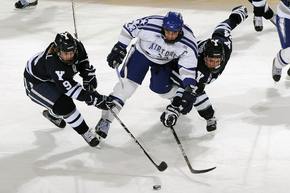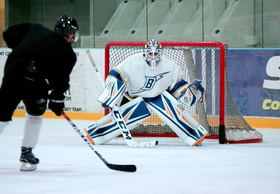NHL Big Hits Concussion Evaluation Test

There have been so many NHL big hits over the years and a quick Google search will bring up loads of videos that you can watch. On this page of our site, we take a look at the concussion management protocols that the NHL have in place to protect hockey players and prevent long-term damage.
NHL Big Hits Lead To Updates in Concussion Protocol
The NHL has implemented a centralized concussion spotter who will help to identify any visible signs of concussion and mandate the removal of players from play. This new concussion protocol was introduced by the National Hockey League at the end of 2016 along with a number of other policies and procedures to enhance the NHL concussion protocol.
It remains the responsibility of the individual club to identify a player who requires removal from play and evaluation for a possible concussion, but the NHL and the NHLPA will now provide additional support to help identify players who require evaluation. Spotters will now monitor all games from the player safety room and they will be authorized to remove players for a concussion evaluation test if players exhibit any visible signs of a concussion following a direct or indirect blow to the head.
Clubs who violate the concussion protocol and do not remove players who require evaluation will be subject to fines. Any player that undergoes a concussion evaluation test will not be permitted to return to play unless and until he has been cleared by the club's medical staff in accordance with the concussion protocol.
On ice officials now have the authority to mandate the removal of a player from the game if the player continues to play after the central league spotter has stated that an evaluation is required.
NHL Big Hits Concussion Evaluation Test and Protocol Steps

The concussion evaluation and management protocol for the NHL lists the procedures that Clubs have to follow regarding concussion education, testing, identification, evaluation, and management. The diagnosis and management of concussion is a decision that is made by each individual club physician based on the protocol.
- Education: Education videos are shown to all players, coaches, medical staff, and club executives so they know about concussions on the first day of training camp. Players who join after this must be shown the video. Educational brochures are also provided and this includes the NHL Concussion Education Program FAQ brochure. All players diagnosed with a concussion are also given this brochure.
- Baseline Testing: Baseline testing is given to all players at the start of training camp. These tests include X2 SCAT3 App annually. ImPACT baseline testing every other year if they have not suffered a concussion in the prior season and if they have valid ImPACT test data from 3 consecutive yearly English language test. All other players undergo ImPACT testing every year. Pen and paper testing is given to players who were diagnosed with a concussion in the previous season.
- Removal from Play for Acute Concussion Evaluation Test: This protocol requires the mandatory removal of players from play for a concussion evaluation test as soon as possible if a concussion is suspected or if any symptoms are evident.
- In-play identification of possible concussion: Spotter observe players behaviours during NHL games. Central League spotters are athletic trainers/therapists with hockey expertise. In-arena spotters view games from the HITS area space permitting. Each league spotter must independently record any visible signs of injury that are observed prior to communicating with each other or the Club medical staff.
- Acute Evaluation: The club physician and or club trainer/therapist examine the player in a distraction-free environment using the X2 app. The player will be assessed in person by the club physician and they will be solely responsible for determining whether or not the player is diagnosed with a concussion.
- Concussion Management: Players diagnosed with or suspecting of having a concussion should be monitored and evaluated over time. Players diagnosed must undergo a period of rest until symptoms have subsided to the point where activity can gradually be introduced. Players must go through a graded progression of activity and each player's concussion is managed on an individual basis. There is no particular program of graded progression nor is there a minimum period of rest.
- Post-Concussion Neuropsychological evaluation: Once a player is determined by the Club physician to be free of concussion symptoms at rest and on exertion, they are referred to the club's consulting neuropsychologist for a post-concussion evaluation. This happens before the player can return to unrestricted practice or game.
- Return to Play: Players cannot return to play on the same day irrespective of how quickly his symptoms resolve. A player may return to unrestricted play once they pass the following three circumstances. These are that there has been a complete recovery of concussion-related symptoms at rest, there is no emergence of symptoms at exertion levels required for competitive play, and the player has been judged by the club's physician to have returned to his neurocognitive baseline following an evaluation by the club consulting neuropsychologist.
Concussion Evaluation Test Symptoms
With so many NFL big hits, it is important to recognise concussion symptoms even with all the technology advancements in sports. If any of the following symptoms or signs occur after a direct blow to the head including blows to the body that cause acceleration/deceleration of the head, the Club will remove the player for an evaluation test.
- Headache
- Dizziness
- Balance or coordination difficulties
- Nausea
- Amnesia for the circumstances surrounding the injury
- Cognitive slowness
- Light/sound sensitivity
- Disorientation
- Visual disturbance
- Tinnitus
- A blow to a player's head or upper torso from another player's shoulder
- A player's head makes secondary contact with the ice
- A player is punched in the head




